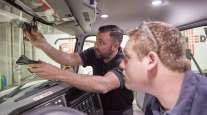Managing Editor, Features and Multimedia
A Safer, More Efficient Future Within Our Grasp
This story appears in the July 11 print edition of iTECH, a supplement to Transport Topics.
Self-driving trucks are coming. The potential benefits to highway safety and freight efficiency, combined with heavy investments in vehicle automation by truck makers and suppliers, are making it increasingly clear that the advent of semi-autonomous trucks on the nation’s highways has become less a question of “if” than of “when.”
 Clevenger
ClevengerThe timing will be determined by how soon the industry can clear some significant remaining hurdles — namely earning public acceptance and securing the necessary legislative and regulatory changes — but the time to take this technology seriously has already arrived.
This issue of iTECH explores many facets of this fascinating development and its potential to dramatically change freight transportation and the truck-driving profession.
Today, truck manufacturers and their suppliers are developing self-driving systems designed to assist rather than replace the driver.
This means that self-driving trucks will not be a panacea for the driver shortage, but they could help indirectly by making the driving profession more attractive. The “cool” factor of autonomous trucks could spur greater interest in the transportation industry as a career opportunity, particularly among the younger generation.
CHAT WITH SETH: TT Technology Editor Seth Clevenger takes your questions, noon EDT, July 18
BEST OF JULY iTECH: More stories, columns
There’s also a chance that self-driving trucks might lead to extended driver productivity. This is only theoretical, of course, but federal regulators might consider rewarding fleets for adopting this safety technology by extending drivers’ hours of service to reflect their reduced workload and lower fatigue. That would create a tremendous financial incentive for fleets to purchase self-driving trucks.
Autonomous driving also holds great potential to reduce fleet insurance costs by preventing crashes.
Beyond that, self-driving trucks could also force some fundamental changes within the insurance industry. In a fully autonomous truck, for example, it seems likely that the vehicle would be considered the driver and crash liability would shift from the trucking company to the supplier of the self-driving system.
In the near term, however, control of the vehicle would pass back and forth between the human driver and the automated system depending on the location and conditions. The liability question could be especially tricky during that intermediate stage, which the industry might be entering within the next several years.
Which form of truck automation would you most readily embrace?
While truck automation may seem like the technology of the future, this is a path the industry has been on for some time, but perhaps didn’t realize it.
Many of the core ingredients of autonomous driving are already on some trucks today.
Adaptive cruise control can automate acceleration and deceleration when activated, collision avoidance systems actively prevent rear-end crashes and lane departure warning systems track when the vehicle strays outside the lane markings.
The last piece of the puzzle is turning those lane departure warnings into active lane keeping by adding automated steering control.
At that point, the truck is capable of accelerating, braking and steering itself — completing the skeleton of a self-driving system.
At the same time, as truck automation advances, the nature of its use will change. While today’s active safety systems generally activate in response to emergencies, a self-driving “autopilot” system represents an active choice to use automation for routine driving situations.
As increasing levels of automation become available on trucks, the same thing will be happening in the passenger car market.
In fact, self-driving cars will likely help pave the way for the commercial vehicle market by making the public more comfortable with the technology while also driving down the costs of the various sensors used to enable autonomous driving.
Fleets interested in getting a jump start on truck automation can do so by implementing current active safety systems, which provide some of the same safety benefits that would be available on an autonomous truck.
However, market penetration for collision avoidance systems, for example, remains relatively modest, even though that technology has been available for years.
Meritor Wabco said adoption of collision avoidance has accelerated recently, but still sits at only about 15% of all new Class 8 trucks sold in the United States.
That raises questions about the adoption patterns for self-driving trucks. When the first self- driving capabilities reach the market, how many fleets will choose to implement the technology? The answer to that question will go a long way toward determining how quickly these systems take hold in trucking.
A safer, more efficient future soon will be there for the taking. But only if we reach out and grasp it.
Seth Clevenger, technology editor, can be reached at 703-838-1795 or sclevenger@ttnews.com. Follow him on Twitter @SethClevenger.




